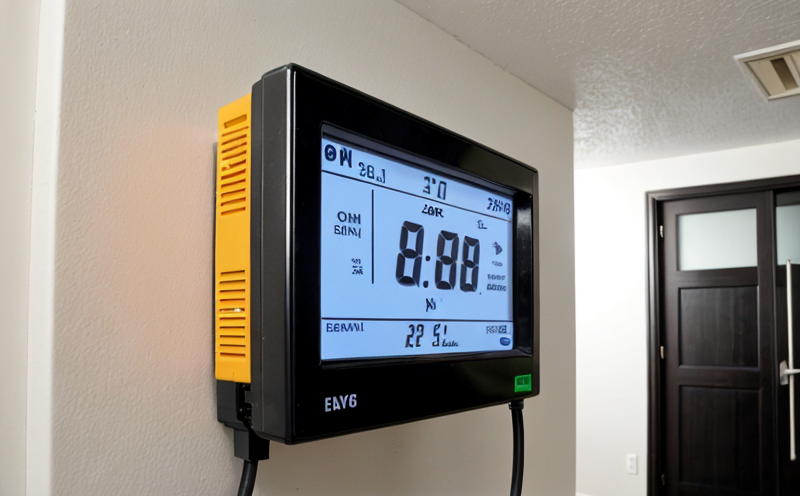EN 14826 Efficiency Testing of Air Handling Units
The European standard EN 14826:2007 specifies the method for determining the efficiency and performance of air handling units (AHUs) in buildings. This test is crucial for assessing the energy consumption and overall efficiency, ensuring compliance with environmental regulations and providing insights into operational costs.
Air handling units are critical components in HVAC systems that help manage indoor climate conditions by circulating and cleaning the air within a building. The testing outlined in EN 14826 ensures these units function as designed, delivering optimal performance while minimizing energy waste. This standard covers a wide range of AHUs, from small commercial units to large industrial systems.
The test involves several key steps, including initial calibration and conditioning of the AHU prior to testing. The unit is then run under controlled conditions that replicate real-world operating scenarios. During this process, multiple parameters are monitored, such as air flow rate, temperature, humidity, pressure drop, and electrical power consumption.
The efficiency of an AHU is typically measured using a coefficient called the Seasonal Energy Efficiency Ratio (SEER). The test results provide this ratio, which helps in evaluating how efficiently the unit converts energy into useful heat or cooling. Higher SEER values indicate better performance, translating to lower operational costs and reduced environmental impact.
Compliance with EN 14826 is mandatory for manufacturers aiming to enter markets that adhere to European Union regulations. This standard ensures interoperability and reliability across different systems within a building, enhancing overall energy management strategies. For quality managers and compliance officers, this test offers critical data needed for regulatory reporting and internal performance evaluations.
- International Acceptance: The results of EN 14826 are widely accepted in Europe and many other regions that adopt European standards, ensuring seamless integration into global supply chains.
- Industry Recognition: Compliance with this standard is also a key factor for R&D engineers when designing new models of air handling units. It provides a benchmark against which performance can be measured and improved.
Why Choose This Test
Choosing the EN 14826 efficiency test for your air handling units is essential for several reasons. First, it provides a comprehensive evaluation of energy consumption and performance under realistic operating conditions. This helps in identifying areas where improvements can be made to enhance overall system efficiency.
The test not only aids in meeting regulatory requirements but also supports sustainability goals by promoting the use of energy-efficient technologies. For procurement teams, this ensures that they are selecting products that meet high standards and contribute positively to their organization's environmental impact.
Moreover, compliance with this standard can lead to cost savings through reduced energy bills. By ensuring optimal performance upfront, unnecessary maintenance costs can also be minimized over the lifecycle of the unit. The test results serve as a valuable tool for continuous improvement in design and manufacturing processes.
R&D engineers benefit significantly from EN 14826 testing by gaining insights into current market trends and customer expectations. This allows them to innovate more effectively, offering products that not only meet but exceed industry standards. For quality managers, the test results provide a robust basis for quality assurance programs, ensuring consistent product performance.
- Regulatory Compliance: Ensures adherence to international and regional regulations, facilitating market entry into Europe and other regions that recognize EN 14826.
- Sustainability Impact: Promotes the use of sustainable technologies that reduce energy consumption and greenhouse gas emissions.
International Acceptance and Recognition
The EN 14826 efficiency test is highly regarded internationally, with its results being widely accepted in Europe and many other parts of the world. This standard has been adopted by countries that have aligned their regulations with those of the European Union, ensuring interoperability between different systems.
Compliance with EN 14826 is not only a requirement for manufacturers but also an attractive feature for potential buyers. It demonstrates a commitment to quality and sustainability, which are increasingly important factors in today’s competitive market. For companies looking to expand their reach into European markets or those that align themselves with international standards, this test provides the necessary credentials.
The widespread acceptance of EN 14826 also extends beyond manufacturing. It is used by regulatory bodies and certification agencies as a benchmark for evaluating the performance of air handling units. This ensures that products meet not only technical specifications but also environmental and safety standards.
- Standardization: The test results are recognized across different regions, promoting standardization in the industry.
- Interoperability: Ensures seamless integration of air handling units into various HVAC systems within a building or facility.
Environmental and Sustainability Contributions
The EN 14826 efficiency test plays a significant role in promoting environmental sustainability by helping to reduce energy consumption and greenhouse gas emissions. By ensuring that air handling units operate at peak efficiency, this standard contributes to lower operational costs and reduced carbon footprints.
Manufacturers who comply with this standard are better positioned to meet increasing demands for sustainable products. This is particularly relevant in the context of climate change mitigation efforts, where energy-efficient technologies play a crucial role. The test results can be used to report on environmental performance, providing transparency and accountability to stakeholders.
For facilities that adopt air handling units certified under EN 14826, there are direct benefits in terms of reduced utility bills and lower emissions. This not only enhances the reputation of the facility but also supports broader sustainability initiatives within an organization. By investing in energy-efficient technologies, companies can contribute positively to global efforts towards a greener future.
- Emissions Reduction: Lowering the operational load on air handling units helps reduce greenhouse gas emissions associated with energy consumption.
- Cost Savings: Optimal performance leads to reduced energy costs, contributing to overall financial sustainability.





